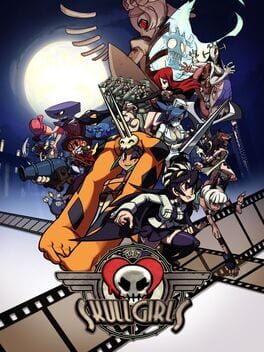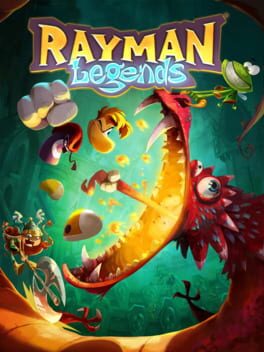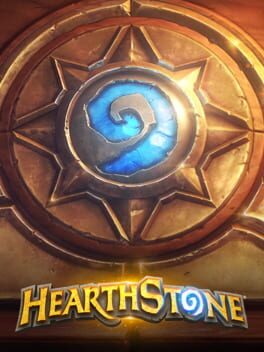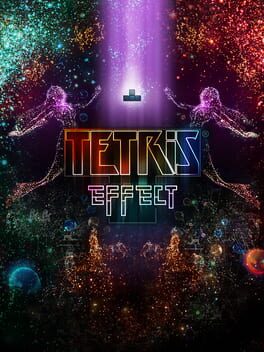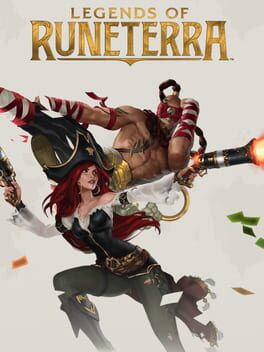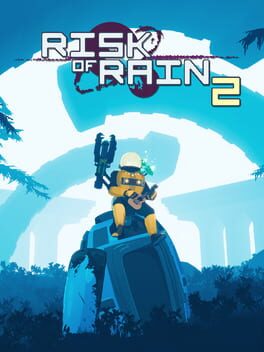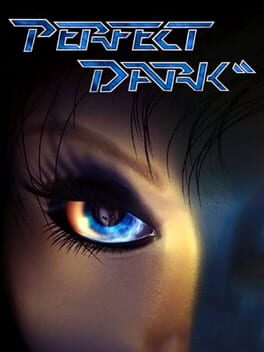synthezoid
2012
1990
2021
2011
2013
This is one of the only single player games I've played to provide more than 100 hours of content (with the expansions) and have every minute of those hours feel justified. Even the side quests feel uniquely planned and cared for, like a labor of love or a second-born child. Choices can have long-term, weighty consequences. Every area in the game feels thought-out and crafted to a degree that some entire games never reach. The Witcher 3 is a rare accomplishment in RPGs, in storytelling, in games--one which occupies our time without wasting it, and one which reminds us that 'breadth' and 'depth' don't have to be antonyms. Bigger isn't always better, but it isn't always worse, either.
2014
A deeply flawed competitive strategy game, but a monumental work of game feel. I still come back to play it on rare occasions, despite its lack of depth relative to other CCGs, its high degree of luck, and its truly horrendous efforts to take my money, because the presentation, setting, and polish allow it to punch well above its weight. Even the simplest of plays can feel more satisfying and impactful than some moments of deep strategy and difficult choicemaking in other card games.
One of the best parts of playing a collectible card game is the tactile feel of rifling through a hand of cards, of your deck mashing together as you shuffle, of sliding sleeved cards across your textured playmat. Instead of slavishly simulating the mechanics of a real card game, Hearthstone offers the basic beats of playing a CCG alongside enough audiovisual spectacle to make up for all those lost physical sensations.
One of the best parts of playing a collectible card game is the tactile feel of rifling through a hand of cards, of your deck mashing together as you shuffle, of sliding sleeved cards across your textured playmat. Instead of slavishly simulating the mechanics of a real card game, Hearthstone offers the basic beats of playing a CCG alongside enough audiovisual spectacle to make up for all those lost physical sensations.
1988
Saved by the excellent All-Stars remake which actually allows you to save your progress. Still, like so many classic platformers, it's let down by an obnoxious lives system that is only marginally tolerable thanks to the mercifully short levels--most of which, on their own, are incredible fun. Their simplicity and concision keep them short and sweet, while the presentation (on both the NES and SNES) gives them an unassailable charm.
The game's biggest addition to the Mario formula is its overworld, which adds both a welcome pace-breaker thanks to its interspersed minigames and roaming enemies, as well as some much-needed player agency in the form of branching paths. These make a great complement to its straightforward, airtight platforming and level design.
Notice how the sprites are chunkier and more clearly defined than in the first game--Mario controls better than he ever had before, and that's due in part to a clear yet characterful visual design that makes every single element distinguishable. Despite its consistent challenge--some of the hardest Mario has ever seen--moments of genuine unfairness are few and far between, outnumbered easily by moments of tedium induced by its pitiful save system.
Its weakest moments come when it pivots too far away from this joyfully simple platforming perfection. Puzzle and exploration-focused levels are hit-or-miss at best, and at worst feel like a premonition of Super Mario World's pace-breaking secret exit hunts. Just let me run and jump already!
The power-ups also feel like an incremental step up from the first game. The clear standout is the raccoon leaf, which affords Mario something to do with his endless momentum, and it's never anything less than blissful to soar over a stage, ignoring everything below. What it lacks in skill compared to Mario World's more demanding cape powerup it makes up for in sheer versatility, making it one of the most empowering tools in Nintendo history.
The game's biggest addition to the Mario formula is its overworld, which adds both a welcome pace-breaker thanks to its interspersed minigames and roaming enemies, as well as some much-needed player agency in the form of branching paths. These make a great complement to its straightforward, airtight platforming and level design.
Notice how the sprites are chunkier and more clearly defined than in the first game--Mario controls better than he ever had before, and that's due in part to a clear yet characterful visual design that makes every single element distinguishable. Despite its consistent challenge--some of the hardest Mario has ever seen--moments of genuine unfairness are few and far between, outnumbered easily by moments of tedium induced by its pitiful save system.
Its weakest moments come when it pivots too far away from this joyfully simple platforming perfection. Puzzle and exploration-focused levels are hit-or-miss at best, and at worst feel like a premonition of Super Mario World's pace-breaking secret exit hunts. Just let me run and jump already!
The power-ups also feel like an incremental step up from the first game. The clear standout is the raccoon leaf, which affords Mario something to do with his endless momentum, and it's never anything less than blissful to soar over a stage, ignoring everything below. What it lacks in skill compared to Mario World's more demanding cape powerup it makes up for in sheer versatility, making it one of the most empowering tools in Nintendo history.
1990
El Shaddai: Ascension of the Metatron is a criminally overlooked and underappreciated gem helmed by director Sawaki Takeyasu, previously a character designer and artist for games like Devil May Cry. While its slightly simpler combat mechanics might feel like a step back for fans of the complexity and intensity of that series, El Shaddai toes the line by providing a sense of novelty and wonder with every level and a colorful, ever-changing world of utter unreality befitting its bizarre apocryphal religious theme. Being ordered around by Lucifer himself on a cell phone will feel like the least unusual thing you've been through by the end of its brisk playtime, and for that feeling alone, it's one of the most memorable experiences I've ever had with a game.
2018
2020
At its mechanical core, probably my favorite digital CCG I've yet played. The turn structure, mana system, reaction spells and fun champions do a lot to set it apart while still scratching that MTG-Hearthstone itch. Neither as complex and unsuited to digital format as Magic nor as simplified and luck-based as Hearthstone, Runeterra sits proudly in my Goldilocks zone. Combine this, too, with being one of the most free-to-play friendly options on the market (up there with Gwent, which is itself a really good game) and you get a recipe for a great, addicting card game that I don't feel bad for coming back to. The developers are also not hesitant to balance and re-balance with regular patches, and the selection of game modes has grown to give it some legs. The main downside is that it doesn't presently have the rich and massive card pool of something like Magic, or even quite the level of Hearthstone, so it doesn't have the same variety that their more wide-open game modes can offer. But what's here, I love. If you don't dig collectible card games mechanically, this probably won't change your mind, but if you do, I don't think there's a better one than this.
The League of Legends universe, which makes for this game's set dressing, is a whole bunch of nonsense that no one cares about, but at least it's fun!
The League of Legends universe, which makes for this game's set dressing, is a whole bunch of nonsense that no one cares about, but at least it's fun!
2017
This game has been talked about to death, hasn’t it? Since its release in 2017, Team Cherry’s ambitious debut has taken the world of indie gaming by storm. We’ve all seen its moody, blue-purple tones and friendly bug-faces gracing our Steam homepages by now. Maybe you’ve already bought the game and wandered its misty hallways for a few hours before dropping it to play Slay the Spire again. It’s okay. I won’t blame you. I did the same at first. Let me tell you why you should give it a closer look.
You’ve probably noticed from countless other reviews by now that Hollow Knight is highly derivative. The names Metroid and Dark Souls will be thrown around a lot. It’s a Metroidvania game (Insectroid?), after all–a game of sprawling, branching corridors locked by sensational and empowering items that serve as de facto keycards for doors you’ve passed and doors you’ve yet to find. Metroidvania games share a common DNA, and Dark Souls takes already takes influence from them, so really it’s just imitating a long line of refined imitations, right? Hollow Knight is just an exemplar of a genre and nothing more?
I wouldn’t say so, illustrative rhetorical question. Hollow Knight does not just distill elements from other games; that would be reductive. Hollow Knight is additive: it takes the formula of a Souls-like-Metroidvania game and then adds to it. It adds all of its interwoven stories and interlocking mechanisms and interconnected levels and interspersed secrets liberally, and uses them to create something distinctly new. The un-restriction of the map and your freedom to explore in so many directions feels bold and unprecedented even for a genre whose primary characteristic is that very freedom because of just how far it takes it. The open-endedness of its levels feels overwhelming in just the right way to inspire curiosity, and sequence-breaking almost loses its meaning given how loose “sequence” already is in the conjoining labyrinths of Hollow Knight. It makes Super Metroid look linear by comparison.
Hollow Knight also learns from its predecessors, carrying both the carefully crafted polish of Metroid and the expansiveness, customizability, and extensive postgame content of Castlevania. It even takes structural cues from Dark Souls, making boss fights engaging challenges that leave you looking forward to the next. (Though only the optional bosses really reach the level of difficulty of a true Souls boss, that’s not a problem–Hollow Knight simply isn’t interested in being Dark Souls, just in learning from its successes. You can see more of this influence in its worldbuilding.) It oozes atmosphere all its own, despite evoking feelings similar to the lonely dread of Metroid, the bleak mystery of Dark Souls, and the Gothic spookiness of Castlevania in equal measure.
The game does not just timidly rehash the decisions of more talented designers; it confidently re-asserts every decision it makes. It’s liable to remind you why you loved those classics by showing you a new experience which rivals the quality of those that inspired it. Hollow Knight‘s design is not a success of repetition, but, much like its gameplay, a success of exploration, finding new opportunities in well-trodden places.
You’ve probably noticed from countless other reviews by now that Hollow Knight is highly derivative. The names Metroid and Dark Souls will be thrown around a lot. It’s a Metroidvania game (Insectroid?), after all–a game of sprawling, branching corridors locked by sensational and empowering items that serve as de facto keycards for doors you’ve passed and doors you’ve yet to find. Metroidvania games share a common DNA, and Dark Souls takes already takes influence from them, so really it’s just imitating a long line of refined imitations, right? Hollow Knight is just an exemplar of a genre and nothing more?
I wouldn’t say so, illustrative rhetorical question. Hollow Knight does not just distill elements from other games; that would be reductive. Hollow Knight is additive: it takes the formula of a Souls-like-Metroidvania game and then adds to it. It adds all of its interwoven stories and interlocking mechanisms and interconnected levels and interspersed secrets liberally, and uses them to create something distinctly new. The un-restriction of the map and your freedom to explore in so many directions feels bold and unprecedented even for a genre whose primary characteristic is that very freedom because of just how far it takes it. The open-endedness of its levels feels overwhelming in just the right way to inspire curiosity, and sequence-breaking almost loses its meaning given how loose “sequence” already is in the conjoining labyrinths of Hollow Knight. It makes Super Metroid look linear by comparison.
Hollow Knight also learns from its predecessors, carrying both the carefully crafted polish of Metroid and the expansiveness, customizability, and extensive postgame content of Castlevania. It even takes structural cues from Dark Souls, making boss fights engaging challenges that leave you looking forward to the next. (Though only the optional bosses really reach the level of difficulty of a true Souls boss, that’s not a problem–Hollow Knight simply isn’t interested in being Dark Souls, just in learning from its successes. You can see more of this influence in its worldbuilding.) It oozes atmosphere all its own, despite evoking feelings similar to the lonely dread of Metroid, the bleak mystery of Dark Souls, and the Gothic spookiness of Castlevania in equal measure.
The game does not just timidly rehash the decisions of more talented designers; it confidently re-asserts every decision it makes. It’s liable to remind you why you loved those classics by showing you a new experience which rivals the quality of those that inspired it. Hollow Knight‘s design is not a success of repetition, but, much like its gameplay, a success of exploration, finding new opportunities in well-trodden places.
2019
Sensory overstimulation in 3D. How does anyone follow what the fuck is going on in this game? When I play with friends, they always ask me "how'd you die?" and every time I say "I don't know." There's so much visual clutter yet so little feedback that something is suddenly tearing through my health bar. It doesn't even get to be tense because it's so unceremonious. Deaths are never punctuated with a "fuck," but a "huh?" Maybe I'm missing something.
The game worlds are expansive yet repetitive, and largely empty beyond the same enemies spawning over and over again to fill the space. Outside of a few interesting movement options on some characters, traversing it is completely uninteresting. Holding shift to sprint helps, but not enough to stop me from wishing traversal was either faster or significantly more engaging. Any kind of platforming or momentum mechanics, even if it wasn't that much faster, would be more bearable. Anything would be welcome, just to add a basic, functional level of engagement to a game that is otherwise about leisurely walking around the projectiles of enemies thirty feet away to trade them some of your own, or, if you're feeling dastardly and playing the appropriate character, approaching to hit them with your fist.
I also don't understand the baffling choice to start players off with the least fun character. [This was improved by the recent update that lets you pick from two to start--the Huntress is less boring, and her 'replacement' in unlock order, the Bandit, is the most fun I've ever had with this game.] I probably wouldn't have ever picked it back up after my first session if I hadn't unlocked the Loader so quickly. The Loader itself is a missed opportunity--how come only one character gets a grappling hook? They're always the best part of any game, and it would help to rectify the dearth of interesting movement tools other characters have.
Navigation in these big, empty worlds with most characters is a matter of holding W and shooting anything you see along the way. Most of the things you find will only be more enemies to shoot or items that you get to press E on. Nothing truly interesting happens getting from point A to B for 90% of the game, which might not be such a big deal if the path from A to B weren't so long and so padded, or if every character had platforming or momentum-driven mechanics. So far, the Bandit is the only character I've found who makes combat engaging enough in itself to ignore how little is truly happening.
Why don't the items in the three-pronged capsules have descriptions before you buy them? They're the same across runs, it's not like what each item does is a secret. It just wastes new players' time as they guess which item might be relevant to them. Then again, the opportunities to actually choose between items that you get are few and far between. There's very little in the way of personalization or buildmaking. There are instead just a lot of generically useful items stacking on top of each other, which makes only a select few truly memorable. This is exacerbated by the fact that so many basic items will be repeated across runs--your character will end up feeling quite similar from run to run. The whole process feels automatic rather than exciting.
Fighting the same boss multiple times in the same run is hugely anticlimactic--so much so that when I first wrote this, I genuinely worried that I was misremembering that detail, because why would you design a roguelite where the level-end bosses can repeat later on? Sadly, I wasn't. Fighting the same boss twice in twenty minutes sure doesn't help the game to feel more substantial or less padded. In fact, much the opposite. In a genre where you can finish most games from scratch in a few hours (if you're good enough), the fact that anything at all feels like padding is the most telling indictment I can think of.
The game worlds are expansive yet repetitive, and largely empty beyond the same enemies spawning over and over again to fill the space. Outside of a few interesting movement options on some characters, traversing it is completely uninteresting. Holding shift to sprint helps, but not enough to stop me from wishing traversal was either faster or significantly more engaging. Any kind of platforming or momentum mechanics, even if it wasn't that much faster, would be more bearable. Anything would be welcome, just to add a basic, functional level of engagement to a game that is otherwise about leisurely walking around the projectiles of enemies thirty feet away to trade them some of your own, or, if you're feeling dastardly and playing the appropriate character, approaching to hit them with your fist.
I also don't understand the baffling choice to start players off with the least fun character. [This was improved by the recent update that lets you pick from two to start--the Huntress is less boring, and her 'replacement' in unlock order, the Bandit, is the most fun I've ever had with this game.] I probably wouldn't have ever picked it back up after my first session if I hadn't unlocked the Loader so quickly. The Loader itself is a missed opportunity--how come only one character gets a grappling hook? They're always the best part of any game, and it would help to rectify the dearth of interesting movement tools other characters have.
Navigation in these big, empty worlds with most characters is a matter of holding W and shooting anything you see along the way. Most of the things you find will only be more enemies to shoot or items that you get to press E on. Nothing truly interesting happens getting from point A to B for 90% of the game, which might not be such a big deal if the path from A to B weren't so long and so padded, or if every character had platforming or momentum-driven mechanics. So far, the Bandit is the only character I've found who makes combat engaging enough in itself to ignore how little is truly happening.
Why don't the items in the three-pronged capsules have descriptions before you buy them? They're the same across runs, it's not like what each item does is a secret. It just wastes new players' time as they guess which item might be relevant to them. Then again, the opportunities to actually choose between items that you get are few and far between. There's very little in the way of personalization or buildmaking. There are instead just a lot of generically useful items stacking on top of each other, which makes only a select few truly memorable. This is exacerbated by the fact that so many basic items will be repeated across runs--your character will end up feeling quite similar from run to run. The whole process feels automatic rather than exciting.
Fighting the same boss multiple times in the same run is hugely anticlimactic--so much so that when I first wrote this, I genuinely worried that I was misremembering that detail, because why would you design a roguelite where the level-end bosses can repeat later on? Sadly, I wasn't. Fighting the same boss twice in twenty minutes sure doesn't help the game to feel more substantial or less padded. In fact, much the opposite. In a genre where you can finish most games from scratch in a few hours (if you're good enough), the fact that anything at all feels like padding is the most telling indictment I can think of.
2000
